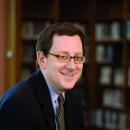Justice Scalia returns for spirited dialogue
With his visit on Feb. 13 and 14 to the University of Chicago Law School, U.S. Supreme Court Justice Antonin Scalia returned to the place where, as a faculty member, he honed his historic contributions to judicial thought.
Scalia explained his guiding principles before a packed Law School auditorium, in a lecture titled "Methodology of Originalism” on Feb. 13. Scalia has long been known as a standard-bearer of originalism, the school of Constitutional interpretation that emphasizes historical context and the original meaning of the framers.
The homecoming also included informal talks with students and faculty members, who had the opportunity to engage Scalia in spirited conversation and debate.
"A whole lot of what I am intellectually is attributable to this place,” Scalia said of the Law School. “[The] University of Chicago is one of two or three of the most formidable intellectual institutions in the world; a really impressive place. You’re lucky to be here, and I’m glad to be back.”
Law School Dean Michael Schill said he “could not be prouder” to welcome Scalia back to the school where he taught from 1977 to 1982.
“I think of the Law School not just as a community, but as a family, and Justice Scalia is very much a part of that family,” Schill said.
Arguments with honesty and humor
Scalia, who was appointed to the Supreme Court by Ronald Reagan in 1986, is one of three recent justices with ties to UChicago: Justice Elena Kagan taught at the Law School from 1991-97, while Justice John Paul Stevens, AB’41, is a College alumnus and a former Law School lecturer.
In his introduction, Schill highlighted the qualities that have defined Scalia’s 25 years on the Supreme Court—his passion for rigorous debate, his lively and prolific prose, and his intellectual honesty.
Schill cited one lesser-known quality of the longest-serving justice on the nation’s highest court. “He also gets more laughs during oral argument than other justice,” Schill noted.
So it was fitting that Scalia drove home one of the major points of his hour-long lecture with a joke. He defended his judicial approach of originalism by telling a joke about two hunters trying to outrun a grizzly bear. “I don’t have to outrun that grizzly bear; I just have to outrun you,” one says to the other.
“It’s the same thing with theories of Constitutional interpretation,” Scalia argued. “I don’t have to prove that originalism is perfect. It’s not perfect. The question is whether it’s better than anything else.”
“And that is not difficult,” he remarked dryly.
History and Jurisprudence
Throughout the lecture, Scalia passionately advocated historical research into the framers’ intent, and defended originalism as the only viable method of constitutional interpretation.
He spoke at length about District of Columbia v. Heller, a landmark 2008 decision that overturned Washington, D.C.’s handgun ban on the grounds that the Second Amendment protects the right of individuals to keep a gun for personal use.
The historical evidence presented to the Court was “overwhelming,” Scalia said: it was clear that, at the time of the framing, owning a gun was considered to be one of the fundamental rights of Englishmen.
Scalia also disputed the petitioners’ contention that the phrase “keep and bear arms” had an exclusively military connotation, arguing it had a broader meaning at the time the Constitution was written.
“I deny the premise that law has nothing to do with historical inquiry,” he said.
Without such historical evidence, the Constitution becomes “what you think it oughta be.”
Yet he argued that the conclusions to be drawn from the historical evidence were the responsibility of the Court, not professional historians. “Figuring out the meaning of legal texts is judges’ work,” he said.
Scalia also touted originalism as a defense against ideologically motivated decisions. “If ideological judging is the malady,” he said, “the avowed application of personal preferences will surely hasten the patient’s demise, and the use of history is far closer to being the cure than it is to being the disease.”
‘Go to Cleveland’
Following the lecture, Scalia answered questions on everything from the originalist interpretation of the Ninth Amendment to the story behind a famous photo of him and Justice Ruth Bader Ginsburg riding an elephant in India. (It was “probably Ruth’s [idea],” he said. “She is an intrepid lady.”)
Student Maria Hassett said Scalia was equally “congenial and down-to-earth” when he guest-taught her Constitutional Law Class on Feb. 13. He began class by discussing the 17th Amendment, which concerns the election of senators, and then allowed students to ask questions for the remainder of the session.
“You could tell he was very passionate about what he believes,” she said. “[I]t’s great to be able to hear where he’s coming from.”
In response to one student’s request for advice from the justice, Scalia stressed the importance of work-life balance in the legal profession, urging students to find a practice that “enables a human existence” and allows for “time to attend to your other responsibilities, to your family, to your church or synagogue, to your community. All of those are real responsibilities,” he said.
Scalia recounted his own experience as a young lawyer at Jones Day in Cleveland, where he never felt pressure to work every weekend.
“Maybe you have to go to Cleveland,” he said.
